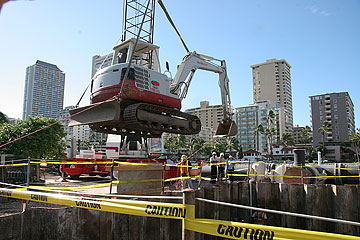'PUSHING THE LIMIT'

CRAIG T. KOJIMA / CKOJIMA@STARBULLETIN.COM
Workers lowered an excavator Wednesday into a 44-foot-deep pit on the mauka side of the Ala Wai Canal. The pit is part of the construction of a microtunnel under the canal to replace a sewer main that ruptured in March. CLICK FOR LARGE
|
|
Microtunneling will be used for Ala Wai sewer main
Work could begin as soon as Friday
WHEN THE CITY pumped 48 million gallons of raw sewage into the Ala Wai Canal for six days in March, it was a record sewage spill for Hawaii -- and one of the largest in the country.
When workers for Frank Coluccio Construction Co. push 1,200 feet of 48-inch-diameter steel pipe under the Ala Wai Canal to create a new sewer main to replace the old one that caused the March spill, they could set another record.
"The pipe we're pushing, nobody has pushed that far," said Bob Partridge, the Coluccio superintendent for the Ala Wai project.
"To our knowledge, we don't know of anybody" that has "pushed pipe" behind an underground microtunneling machine farther than 1,100 feet, Partridge said. That record was on another Coluccio job in Hawaii, installing underground pipe for Haseko's Ewa Beach development, he said.
Despite "pushing the limit" of what could be possible with microtunneling pipes underground, Partridge said he is confident his team can do the job.
The fact that the pipe will travel underneath the Ala Wai Canal is less of an issue than the uninterrupted distance it is going, he said.
The microtunneling run will start behind Ala Wai Elementary, on the canal's mauka bank, in a pit 44 feet deep and will end at the city parking lot at Kaiolu Street and Kuhio Avenue in Waikiki. A receiving pit to be built on that end will be about 20 feet deep, said Lee Porter, senior project inspector for construction manager M & E Pacific Inc.
The Seattle-based Coluccio's other microtunneling jobs in Hawaii have included sewer work underneath Nimitz Highway, and the Kalaheo Avenue and Hamakua-Keolu-Kainehe projects in Kailua.
The advantage of microtunneling -- which creates a tunnel just big enough to insert a steel pipe -- is that it allows less disruption of life on the surface while underground pipes are being installed. In the Ala Wai case, the microtunneling will mean no digging up of Kaiolu Street.
The same five-person Coluccio team that recently completed the Kalaheo job will start tunneling under the Ala Wai Canal as soon as Friday, Partridge said.
Once microtunneling begins, it will continue "24/7" until the job is done, Porter said. That will take an estimated 20 days, at about 60 feet per day, he said.
Stopping the $1 million machine's cutting head increases the chance of it getting stuck, Porter said. If that were to happen, the machine would have to be abandoned where it was and an entirely new tunnel dug, Porter said.
"If it gets stuck under the canal ... there would be no way you can extract it," Porter said. "But that's not going to happen."
Preventive measures include constantly bathing the cutting head with a mixture of water and bentonite lubricant, he said.
Once the metal pipe is in place, a 36-inch fiberglass pipe will be installed inside, and concrete will be injected between them, effectively fusing the two pipes into one unit, Porter said.
While the new sewer line under the Ala Wai Canal is being tunneled, Waikiki and Manoa's load of 12 million to 15 million gallons of sewage a day will be flowing through the temporary bypass pipe installed alongside and in the Ala Wai Canal last summer. The high-density polyethylene bypass pipe took over carrying the area's sewage a few weeks ago, said Craig Nishimura, deputy director of the city's Department of Design and Construction.
When the permanent pipe underneath the canal is completed, the Beachwalk sewage pump station will be reactivated, and the temporary pumps on the makai canal bank will be removed, Nishimura said. However, sewage will continue to flow through the pipe sunk to the bottom of the canal, he said.
Work on the $15 million temporary bypass began May 30 after Gov. Linda Lingle waived normal state permitting rules because of the potential disaster of another sewer break. The March spill closed Waikiki beaches for several days and made unflattering headlines across the country.
The city has asked that Lingle extend her emergency proclamation that expires at the end of January until July, Nishimura said. The city also is pondering whether it will ask for an emergency proclamation to build a new permanent sewer line under the mauka bank of the Ala Wai, he said.
Under normal procedures, building that new line, estimated to cost $30 million, will take six years, during which time the polyethylene temporary line would be used, he said.
Donna Wong, executive director of Hawaii's Thousand Friends, questioned the wisdom of that tactic.
"If the temporary line is in and apparently working well, it appears that the emergency is over," Wong said. "So any work in the future should be done under the existing permitting system, which is intended to protect the environment and alert the community of potential issues."

